Dell UltraSharp U2711: Quality has a Price
by Jarred Walton on January 22, 2010 2:00 AM EST- Posted in
- Displays
Dell U2711 Color Quality
We'll start with a look at the color quality of the U2711, broken down into two areas: Color gamut and color accuracy (i.e. Delta E). We'll start by explaining the former. Color gamut refers to the ability for a display to represent all of the colors in a defined selection of colors. In this case, we use the Adobe RGB standard to define the base gamut, and we measure the percentage of that standard that a display is able to cover - higher being better.
Delta E is the difference between a requested color and the color that actually appears on the display, with lower being better - i.e. the displayed color doesn't have a large delta relative to what was requested. If a display has perfect color accuracy, Delta E will be 0.0; in practice, anything less than 1.0 is nearly perfect and no one will notice the difference. A Delta E of 2.0 or less is the desired result after calibration, meaning no one color measures higher than 2.0 on our standard 24 color palette. Such a result would be fit for use in any professional imaging environment. Finally, while Delta E of around 4.0 is visible to the naked eye, it's really a question of reference points; if you don't have something better nearby and you're not going to print or view content on other media, a result where all colors measure 4.0 or less is very good.
So how does the U2711 do in these areas? First let's look at the charts, and then we'll discuss what they mean. We used the Graphics and Adobe RGB setting on the U2711, with brightness set at 36% (~200nits) and contrast at the default 50%.
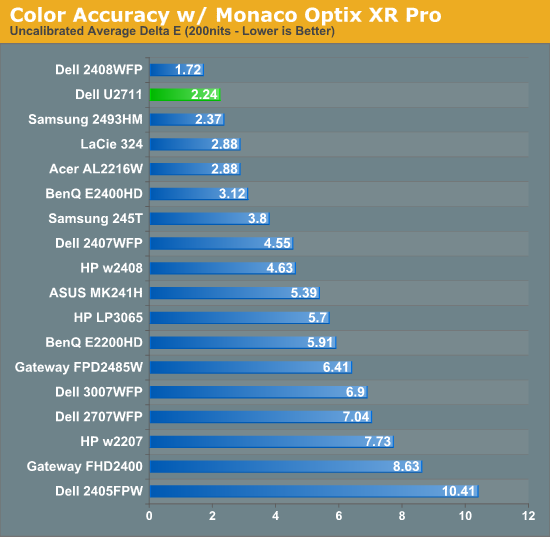
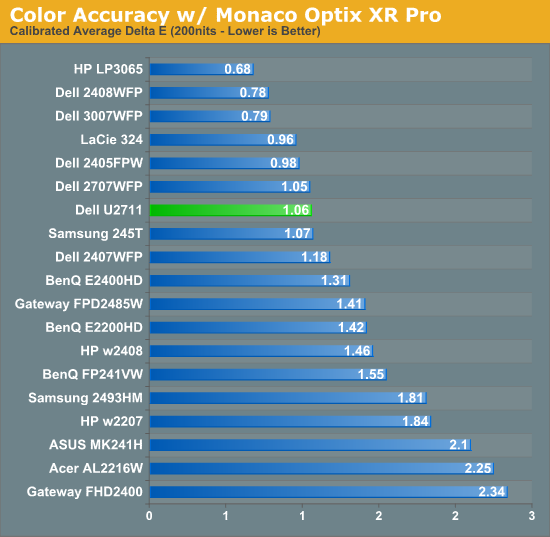
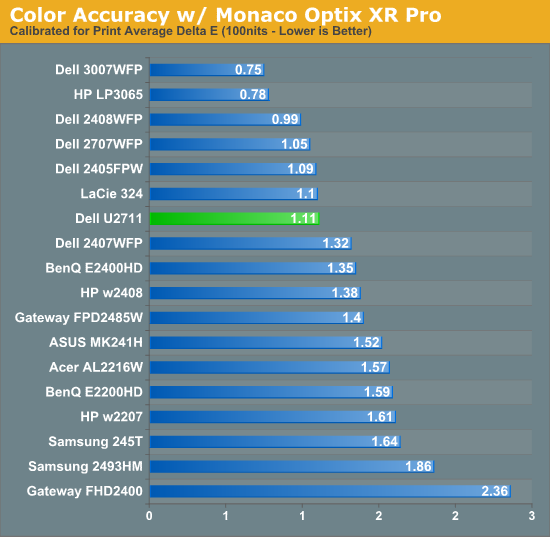
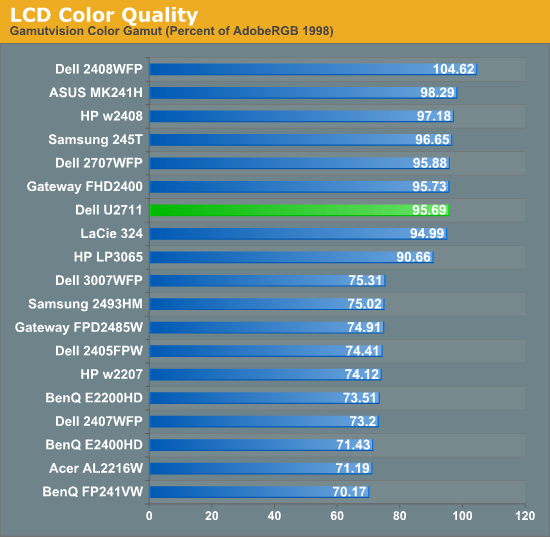
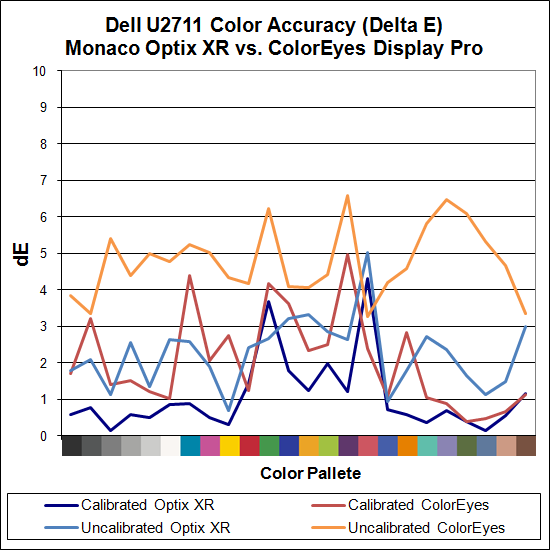
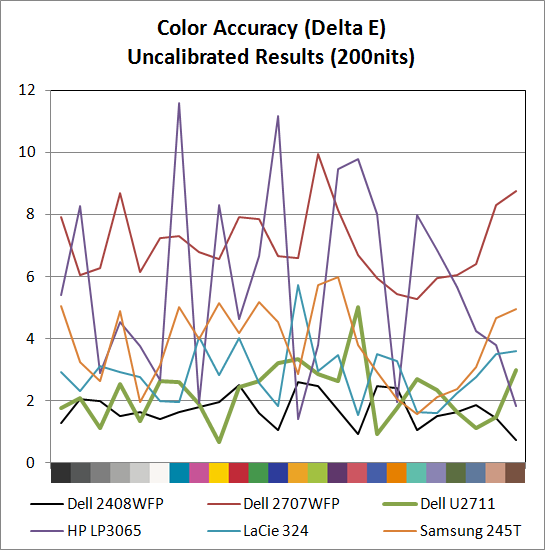
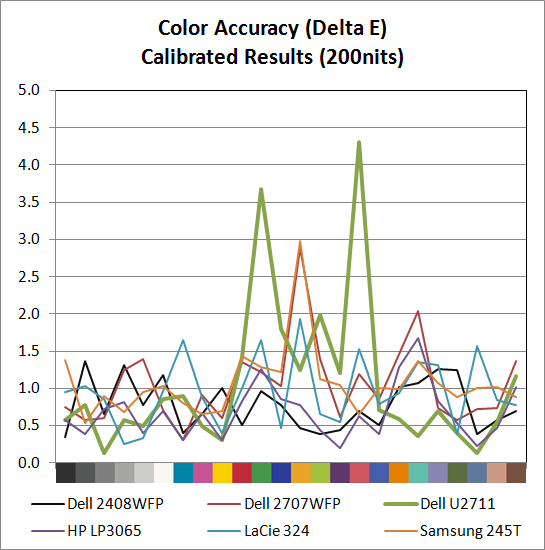
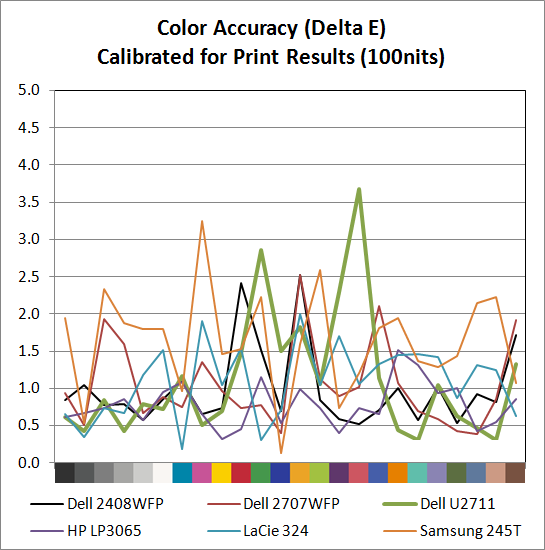
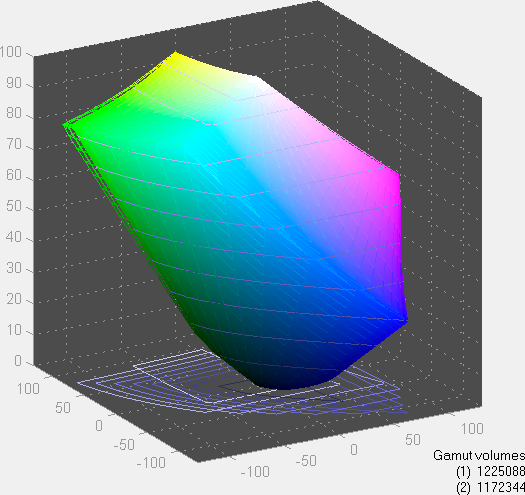
The U2711 scores extremely well in color gamut, and it achieves the 96% of Adobe RGB that Dell claims in their literature (not that most users would really notice the difference between any of the displays rated 90% to 105% - at least not after you eliminate the TN panels). Color accuracy on the other hand is a bit of a mixed bag. Dell ships a paper with test results showing the color calibration of each individual U2711, with the claim that the displays will have an average Delta E of less than 5.0 without any end-user calibration (when using the sRGB and Adobe RGB settings). Dell uses Minolta Color Analyzer CA210 and 32 test colors while we test with ColorEyes Display Pro and Monaco Optix XR Pro and 24 test colors, but our Monaco results confirm their claim. We're not sure why, but we continue to get better results using Optix XR Pro than with ColorEyes Display Pro.
As far as Optix is concerned, the U2711 achieves the rated Delta E of < 5.0 at just 2.24 without calibration, which is an excellent result. In fact the U2711 has no colors in the standard Gretag Macbeth 24 color palette score higher than 5.0 (and only reddish-pink scores a 5.0 measurement). The only LCD we've tested that did better is Dell's own 2408WFP (which also, interestingly enough, had an Adobe RGB color gamut of 105%). ColorEyes also gives an average Delta E of less than 5.0, but at 4.78 the score isn't nearly as remarkable, with nine color measurements well above 5.0. The uncalibrated (Monaco) results put the U2711 ahead of the HP LP3065, Dell 2707WFP, Samsung 245T, and LaCie 324 - and just about every other LCD we've tested.
Switch to the calibrated results and the U2711 doesn't impress quite as much relative to the competition. Monaco gives the U2711 an average Delta E of 1.06, which is great, but there are two results above 3.0 (the worst is reddish-pink again, this time at 4.31) compared to displays like the HP LP3065 where the highest measured Delta E is just 1.68. Dell's own 2707WFP, a three-year-old offering, also delivered a similar average Delta E but with only two colors above 2.0 (and still under 3.0). For a better LCD (i.e. not a TN panel), the results are really only slightly above average. It is possible different calibration software would achieve a better end result, but really we're talking about a "problem" that only the most demanding users are likely to ever notice.
Color Consistency
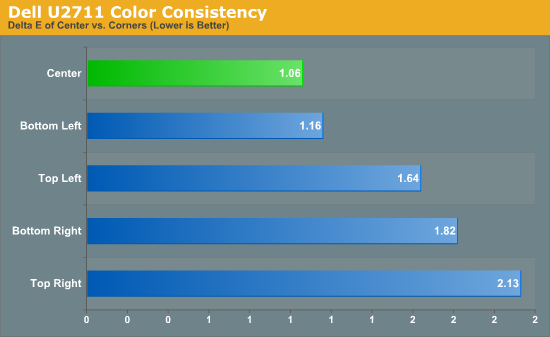
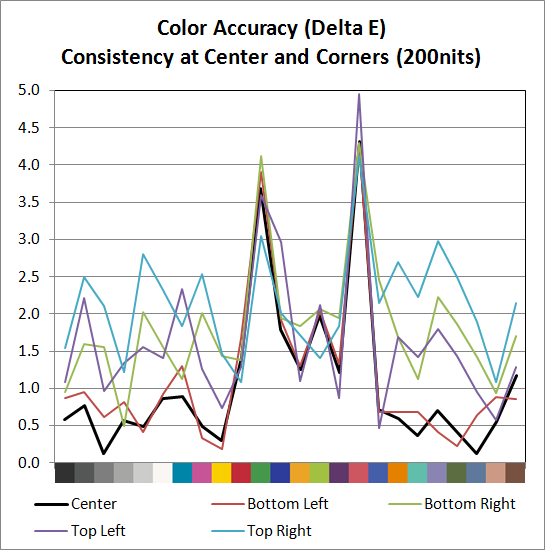
We added another test to try and measure the panel consistency across the entire surface. We measure Delta E at the center of the display, but what happens on the edges? To test this, we used the same profile generated in our best Delta E test result and measured Delta E again at the four corners. Most of the scores are similar, with a slight increase in average Delta E relative to the center measurement. The bottom-left corner is nearly identical to the center measurement, the top-left and bottom-right are a bit worse, and the top-right corner gets the overall worst result. While on the one hand we could say that the Delta E on the top-right is twice that of the center measurement, it's not a case of being "twice as bad". In fact, the color consistency is very good, and we didn't notice any "hot spots" are areas where the colors were clearly off relative to the rest of the LCD.










153 Comments
View All Comments
JarredWalton - Friday, January 22, 2010 - link
Honestly, I'm sitting in from of my 3007WFP (not the HC version) and moving my head around and I just can't see anything. LOL.I'm looking at a white background and I can't see anything bothersome. I just did the same thing with a couple glossy laptops as well as the U2711 and I'm still not seeing anything sparkly. In fact, I just wandered around my lab and looked at six different LCDs (laptop and desktop, glossy and matte) and I'm still at a loss.
I might actually sort of see what you're referring to, but even then it just doesn't register as something distracting to my brain/eyes. My best guess is that either my eyes just aren't good enough to see it well (entirely possible), or my brain has adapted to where this effect doesn't affect me.
This is something I try to get across in my display reviews: you know what bothers you and I know what bothers me, and sometimes something that I totally don't see will irritate the hell out of others. If you can see/test a display in person, that's your best bet obviously. I figure if you're spending $1000 on a display, you'll want to do everything you can to make sure it's the right panel for you in advance of laying out the cash.
Caveat emptor, eh?
The0ne - Wednesday, January 27, 2010 - link
Not really. Most of the issues people are referring to and talking about are what I like to call "subjective preferences." People want things the way they like them to be will pay more attention to the features, defects, etc. For most users, they aren't even aware of most of this features/defects to even begin realizing and thus not seeing.Selecting a TV is no different. However, once you do start to pay attention to what others are saying then you will begin to notice as it becomes more apparent.
If you can't see and anomalies on your 30" I wouldn't worry about it or bother to do research. Doing so might just ruin your enjoyment of it. For those that care way way too much, they usually end up here...
AVS forums :o
MadMan007 - Friday, January 22, 2010 - link
You don't need to mvoe your head around to see it. I can get the same sort of thing only less severe on my LP2475W but only if I'm less than one foot away which is not normal use. With Dells I see it very easily from normal distance (2-3 feet.)If Dell still has a solid 100% back free shipping return policy on monitors there's little risk in trying them. All I know is when I tried a 2407WFP a few years back even without reference to another LCD I was like 'wtf is this?' and then found comments about the same thing from others. But obviously there are plenty of people who like Dell monitors so it's all personal preference. I was coming from a CRT and it was my first shot at an LCD if that matters but still it was immediately noticable to me. Maybe lighting plays a role too *shrug*
Given their return policy (if it's still the same) I don't see any problem recommending people try Dell monitors. The strong anti-glare is just something that for people who know they don't like it to the extent it's a deal breaker want to know ahead of time so they just won't bother.
icrf - Friday, January 22, 2010 - link
I've got a refurb 3007WFP-HC and it's definitely got the sparkliness going on. I only really noticed it when I first got the display and was scouring for dead pixels (got a couple, but they're hard to see, and the rest is immaculate, so I kept it). I guess I've gotten used to the sparkling, which is a much better term than grainy. It's never bothered me. I strongly prefer it to seeing a reflection of myself like a gloss finish.MadMan007 - Saturday, January 23, 2010 - link
I guess that's what sucks about being ugly :( ! lol :Ddasgib - Friday, January 22, 2010 - link
Thanks for your answer.Just to clarify: large white areas are shown as large, white areas, not as "large dusty/grained kind-of-white-but-not-really-white" areas? ;-)
Anyway, I'm really looking forward to the release of the devise. I haven't found any 24-inch that has no crappy colours or that frickin' grain :(
The LP2475w has _incredible_ colours and a very deep black - but it's extremely grainy - even in comparison to a really, really old and really cheap 22-inch TN panel.
MadMan007 - Friday, January 22, 2010 - link
If he says it looks the same as the 3007WFP then it likely has the typical Dell anti-glare coating. I just don't think he knows what it looks like or doesn't notice it any more. It just doesn't bother some people.hadphild - Friday, January 22, 2010 - link
Does this monitor cope with different Hz ranges?I am really looking for a monitor that can cope with all hz range up to 60hz. I work in a pro video environment and regularly need to use 50Hz outputs.
Patrick Wolf - Friday, January 22, 2010 - link
The only reason I'd see a gamer wanting this is if a resolution that high is really worth sacrificing size since you could just get a much larger (42"?) quality 1080P HDTV for roughly the same price.erple2 - Saturday, January 23, 2010 - link
If I'm doing work? Yes, I'd much, MUCH rather have more vertical pixels than a larger screen, no comparison at all. I'd pay significantly more for it too, than a "High Quality" TV with crummy resolution.I love the 1920x1200 15" screen on my laptop, thank you very much. I love the fact that I can see 4 windows at the same time on it. Using the company provided 14" screen with an (IMO) appalling 1280x800 resolution makes me feel so ... cramped.